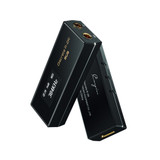

Cayin RU7
Discrete Resistor Network 1-Bit Dongle DAC + Headphone Amplifier
1-Bit Goes Mobile
Most modern dongle DACs use an off-the-shelf delta-sigma chip implementation. But these days, some music lovers crave the sound only a ladder DAC implementation can provide.
A classic technology that’s been making a comeback, R-2R and 1-Bit are known to produce smooth, realistic, natural sound and can have benefits in spatial awareness and staging. But because this type of design requires expensive high-precision matched resistors (and a lot of them), it's been prohibitively costly and difficult to miniaturize.
Cayin finally made it happen with the original RU6, and now, the new RU7.
Fully Balanced Resistor Network
While the DAC of both RU6 and RU7 are resistor-network based, the 96 pieces (2x48) resistor network in RU6 is a stereo (2-ch) R-2R implementation, the 128 pieces (4x32) resistor network in RU7 is a fully balanced 4-ch DAC design. Although we need to convert the DAC output to single-ended for subsequent processing, the fully balanced DAC can render more detail and preserve more dynamics of the music. If we treat R-2R and 1-Bit as two different but equal engineering approaches to convert the digital audio bitstream to the analog waveform, the fully balanced design in RU7 will still be a step up from the singled-end design in RU6.
Parallel Driven Dual Amplifiers
We want to provide an upgrade headphone amplification to as many users as possible with RU7, so we revised the circuit to parallel dual amplifiers, delivering 80% more power when balanced driven with similar overall power consumption.



We’re here to answer your questions and help you make the right choice.

Our advisers and technicians are standing by to assist after your purchase.
